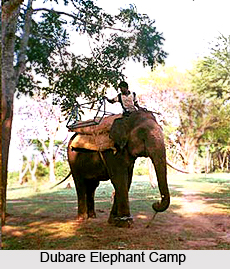 Dubare Elephant Camp is located near Madikeri in the Kodagu District of Karnataka. It is located on the other side of the river and accessible by a small boat ride. The Dubare Elephant Camp is a famous training camp of Coorg in Mysore. The Karnataka Forest Department has about 150 Elephants. It attracts a number of tourists who visit the camp to observe the various activities of these gigantic creatures. The Elephants for the famous Mysore Dassehra Festival were trained at Dubare elephant camp. Situated on the banks of River Cauveri, the Dubare elephant camp introduces the tourists to the various aspects of this awe-inspiring animal.
Dubare Elephant Camp is located near Madikeri in the Kodagu District of Karnataka. It is located on the other side of the river and accessible by a small boat ride. The Dubare Elephant Camp is a famous training camp of Coorg in Mysore. The Karnataka Forest Department has about 150 Elephants. It attracts a number of tourists who visit the camp to observe the various activities of these gigantic creatures. The Elephants for the famous Mysore Dassehra Festival were trained at Dubare elephant camp. Situated on the banks of River Cauveri, the Dubare elephant camp introduces the tourists to the various aspects of this awe-inspiring animal.
Karnataka is one of those places where elephants are found abundantly. While some were used during festivals the others were used for transporting logs. However with time these animals were out of business. And then they needed to be looked after. The government spent a hefty sum to maintain these animals. It is then that a project on Dubare Elephant Camp conceived. The main aim of the camp is to attract tourists and offer them with an opportunity to take a closer look at these majestic beings.
Flora and Fauna of Dubare Elephant Camp
The moist deciduous forest is the habitat of a range of wildlife. The Dubare Elephant Camp in Karnataka is run by the Karnataka Forest department and is the home to more than 150 elephants. Various herds of Sambar and spotted deer grazing on the banks can also be seen here. Dubare is home to a variety of birds like partridges, woodpeckers, kingfishers and many more. The chirping of birds and the humming of various insects make the place serene. Peacocks can also be seen here. During sunset, flocks of birds flying across the twilight sky add to the scenic beauty of the place.
Tourism in Dubare Elephant Camp
Tourists can find a number of trained Naturalists in the Dubare Elephant Camp in Karnataka who guides the tourists about the diverse aspects of the history and ecology of the elephants. The Dubare Elephant Camp is a unique eco-tourism destination in South India.
Dubare Elephant Camp in Coorg is of historical importance. In the ancient times a number of elephants were brought here for their initial training. Presently the Dubare Elephant Camp provides a thrilling experience of watching the elephants feeding on sugarcane, coconuts or bananas. The elephants of the Dubare Elephant Camp are trained to carry heavy logs, lift them and stacking logs in a symmetrical pile.
This is a programme through which awareness is created about these mammals. An expert is always around at Dubare Elephant Camp to explain all that is required about elephants. Here one can learn about evolution, history, ecology and biology of elephants. It also helps to eradicate all kinds of wrong ideas that men may have about these hefty beings. Later the travelers can participate in various activities that involve these animals. Promoting awareness about elephant conservation and eco tourism are the forte of Dubare Elephant Camp, Karnataka.
Tourists can also enjoy river rafting during the time of rainy season. The weather generally remains pleasant round the year. Monsoon begins during the month of June and rain continues to lash out in heavy torrents until mid-September. The post-monsoon season, between mid-September and March, is the favourable time to visit when the nature starts to sparkle with lush greenery.



















